Abstract
Remote monitoring of a patient’s physical rehabilitation process after knee surgery is crucial, especially in instances such as pandemics, where patients may not be able to acquire ongoing postoperative care owing to the precautions implemented. Wearable technology can be used to track a patient’s development and ensure that they follow rehabilitation guidelines. An active rotation control (ARC) knee brace was developed to guide and facilitate physical therapy movements of patients with knee injuries in an actively controlled manner. The system can trigger a visual feedback mechanism when the subject performs various knee postures. Through the Internet, caregivers could obtain patients’ overall knee-related rehabilitation metrics. The ARC knee brace employs inertial motion tracking technology which is based on low-cost inertial sensors and data processing algorithms to capture user’s knee posture in real-time during rehabilitation process. The inertial measurement units (IMUs) containing a combination of accelerometer and gyroscope are used as motion sensors to measure accelerations and rotational rates of knee. The sensors track data include acceleration, rotation, and temperature. The processing system calculates various metrics from the posture of knee.
1. Introduction
Knee injuries are frequent, irrespective of the gender, age, and demographic factors, and may necessitate costly and lengthy treatment methods [1,2,3]. A patient’s recovery from a knee injury is generally reliant on their commitment to their allocated rehabilitation procedures. It is advantageous for sportsmen to do the motions prescribed for knee injuries at physical therapy facilities under the supervision of a professional. However, if an athlete is unable or does not choose to visit the physical therapy clinic, these motions are performed alone. When the intended knee stretching/opening cannot be accomplished during individual studies due to the fear of making a mistake or injuring oneself, the treatment procedure and, thus, the time to achieve knee mobility rises.
Wearable technologies are commonly utilized in the therapeutic field to examine mechanical analyses of movement in neurological and orthopedic disorders for helping patients’ treatment programs inside and outside of a clinical setting [4,5,6,7,8,9,10]. The literature survey demonstrates that joint angle estimation/measurement is quite important when it comes to monitoring orthopedic injury recovery [11], e.g., knee for such wearable technologies. Consequently, many different types of sensors, including textile-based ones, have either been developed or used to accomplish this very task. The survey also points out that modelling wearable physical therapy systems without compromising user’s comfort and evaluating these models on user study data whenever possible are the main concerns of the studies [12,13,14,15,16]. In addition to the products of the scientific works, there are also some commercially available wearable devices for injury rehabilitation. However, majority of these systems are based on “monitoring and/or providing continuous passive motion (CPM) with the wearer”. Since these systems have isotonic movements, they are typically utilized as devices to ensure joint mobility in injury rehabilitation processes without an active muscle contraction. Although medical experts’ overall assessment of the benefits of such devices is positive, they do not allow the muscle to contract voluntarily; thus, depending on the patient’s condition, the expected effect in regaining “old” muscle strength may not be seen. Moreover, continuous passive motion (CPM) devices do occupy large areas and may be composed of many components and accessories; therefore, they may need assistance for use. Products such as patella open lateral support knee pads, which are prescribed for athletes with knee injuries, are, on the other hand, simply meant to assist the athlete protect himself and/or promote such motions during every day routine activities (such as walking), though such products may be employed together with CPM or isotonic movement devices [17,18,19].
In light of the literature, the study under discussion is conducted to develop a wearable knee brace that is not only light-weight, easy to use, and affordable, but also contributes to the development of sustainable e-textiles approach to some extent. The active rotation control (ARC) knee brace is composed of medical textile products (e.g., knee pads and knee cuffs), an electronic circuit that can be integrated into the textile substrate, and a code (software) for the circuit which is written to produce real-time data for monitoring one’s knee mobility gaining performance in parallel to the physical therapy movements prescribed. Unlike continuous passive motion (CPM) devices, the active rotation control (ARC) knee brace offers a rehabilitation process with an active muscle contraction.
2. Material and Method
2.1. Material
A patella open lateral support knee pad is used as a substrate to integrate the electrical designs, such that it largely results in dependable and minimal patient obstruction. The electrical design that can be integrated to the textile-based lateral support is, however, composed of gyro sensors, an Arduino Wi-Fi serial module ESP8266 with built-in TCP/IP networking software, and connecting cables with microcontroller capability and a light diode. The Wi-Fi serial transceiver module ESP8266 and the sensors are covered using special cases created using SketchUp 3D Design Software modelling program [20,21,22,23]. Instead of location sensors which are very expensive and not easy to find, MPU6050gyro sensors are employed in the system to monitor the angular rotation rate of knee. The other component of the model is LED indication for a visual control system [24]. Finally, the complementary filters (CFs), connected to the high-frequency gyro output, are employed to monitor the knee’s angular position by eliminating noise so that much clearer data reading can be realized.
2.2. Method
Modelling and Prototype Development
The ARC knee brace employs inertial motion tracking technology which is based on low-cost inertial sensors and data processing algorithms to capture the user’s knee posture in real-time during rehabilitation process. The inertial measurement units (IMUs) containing a combination of accelerometer and gyroscope are used as motion sensors to measure accelerations and rotational rates of knee. The ARC knee brace prototype is divided into two sections. The first section is the control patch houses all of the electronic components and cannot be washed. The second section, however, is the textile-based neoprene brace (patella open lateral support knee pad) itself. The smart electronic parts can be integrated into the textile-based knee brace of small, medium, and large sizes. The ARC knee brace weighs approximately 350 g. So, the whole system does not put an unnecessary pressure on user’s knee during therapy. The system is designed to be employed for short- and long-term physical therapy and/or recovery movements. Figure 1a depicts the electronic system as well as its interaction with the user. Figure 1b, on the other hand, presents the working principle of the prototype, namely the algorithm of the code.
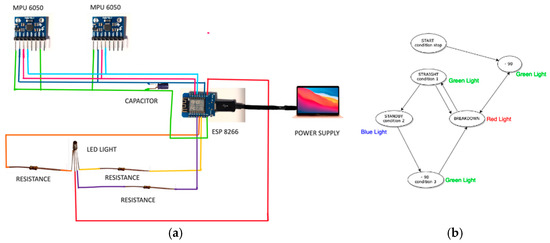
Figure 1.
Details of the model: (a) design of electronic system and (b) schematic representation of working principle of the model.
The free-source Arduino library gives three metrics for the gyro sensors. These are acceleration (m/s2 in X-Y-Z coordinates), rotation X (degree per second), and temperature (degree Celsius) [25]. Due to the incompatibility between the read values (degree/s) and the intended value (degree), the unit change is implemented in the code by adding the relevant mathematical computations so that the model can calculate knee angles based on the angular velocity and acceleration. The gyro sensor “MPU6050 0x68” collects and transmits data to IoT devices with eight pins. The VCC, GND, SCL, and SDA pins of the sensors are used in the circuit, whereas the gyro sensor “MPU6050 0x69” communicates through one extra pin, namely AD0. Since the gyro sensors contain noise, i.e., one of their most common output errors, an additional (complimentary) filter is also utilized for the circuit design. For data collection, the first gyro sensor MPU6050 0x68 is attached to the ESP8266 Arduino Wi-Fi module through a 0x68 channel, whereas the second gyro is connected to the very same Wi-Fi module via 0x69 channel [25]. Furthermore, 44 Hz is selected as the best acceptable frequency for our study from a range of 5–260 Hz intermittent values offered by the gyro. The minimum rotation value (degree/s) for the gyro is 250 degrees/s and is selected as the maximum limit for the design. The data collected comprises acceleration and rotation angle, and it is processed such that the graph of knee position against acceleration is obtained using the accelerometer’s functioning principles. For the LED lighting of three colors, a connection between three distinct legs and three identically resistances are used. The goal of including a capacitor in the design is to protect IoT devices, in addition to extending the lifespan of the sensor. The pin and color codes are established in the developed code. For the work, three primary colors, namely red, green, and blue, are chosen, and depending on the voltage levels transmitted to the LEDs, the system activates the correct color.
The extremities of the knee movements are full extension and complete flexion [16,25]. As is well known from medicine, knee motion covers the maximum range of 140 degrees [25]. Accordingly, in the design of the ARC brace, extension of the knee refers to an angle increase in the bent knee joint. As previously explained, the bending angle information in the code is read in terms of rotation per second (degree/s), and the system architecture converts it to degrees.
3. Result and Discussion
The ARC knee brace can be integrated with the appropriate textile-based knee pads recommended by physicians. The brace, together with the relevant knee bending positions, is given in Figure 2, whereas the validation of the system running is demonstrated in Figure 3 and Figure 4.
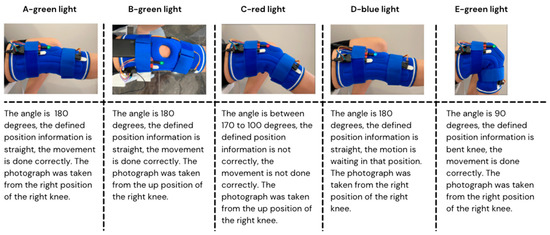
Figure 2.
The knee bending test of the ARC knee brace.
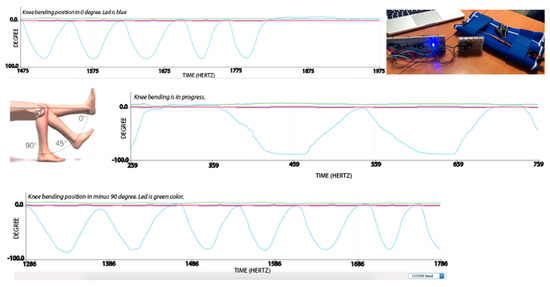
Figure 3.
The prototype of the ARC knee brace and the momentary data taken from it for different knee bending positions from minus 90 and 0 degree (from down to up).
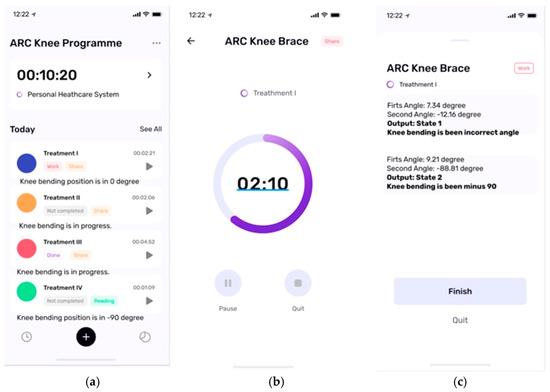
Figure 4.
UX/UI design from the application interface for ARC knee brace: (a) exercise data collection; (b) timer motivation; and (c) ARC knee brace program outcome.
When the brace is run, it reads the real-time angular data for the current knee position. If the knee angle hits −90 degree, the LED turns into green, whilst the LED goes red for the incorrect knee positioning. Finally, the LED changes back to green at the angle of 0 degrees (Figure 1b, Figure 2A–E and Figure 3). During a treatment, the system waits for 20 s before it changes the green light to the blue one at the appropriate bending angle of the knee. The blue light indicates that the movement required for that particular phase of the treatment has been completed properly (Figure 2A–E and Figure 3). As seen from Figure 3, the knee improvement can be measured by the amount of knee extension (in the angular sense), which is more objective criteria, in comparison to the use of pain scales for knee mobility recovery testing, such as visual analogue scale (VAS) [26]. The data viewing, recording, and sharing options of the system are provided with users. The data can also be shared with the relevant specialist through the mobile application developed (Figure 4), if required. As is well known, the UI design process is a collection of interface animation, visual elements, screen layout, and content. The user experience and interface (UX/UI) design of the application allows the user to capture and monitor the observed data (Figure 4). For the brace under discussion, the IOS design color and the knee position codes are developed using the relevant public sources [27]. To do so, offering the user a more attentive interface has become the focal point of the main CSS codes (Figure 5), though there is no doubt that the application may be further improved to make it more user-friendly.
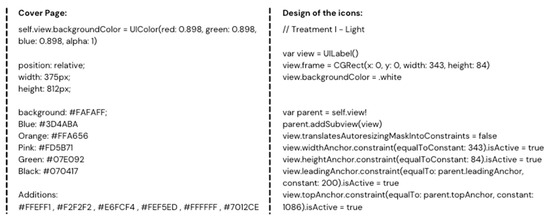
Figure 5.
Some parts of the CSS codes.
The power supply provided to the system can be connected to the power. It works in connection with a computer via USB so that it can monitor the real-time graphics produced corresponding to the relevant knee movements. External power banks, the phone with a converter patch cable, or some other computer-derived equipment are the other alternative sources that can be attached to the system using the appropriate intermediate cables.
As a final word, it should be noted that feedback from actual users is needed to make the system more user-friendly and more efficient, which is the scope of further study.
4. Conclusions
The ARC knee brace discussed in this study is developed to contribute to physical therapy processes of athletes and/or ordinary individuals with knee injuries, in a relatively more self-dependent and affordable manner. The brace differentiates itself from the similar devices/products such that, unlike the other devices, it is designed for active knee motion control. Furthermore, the ARC knee brace is easy to use and affordable because it employs inertial motion tracking technology which is based on low-cost inertial sensors and data processing algorithms to capture the user’s knee posture in real time during rehabilitation process. Moreover, it is an environmentally friendly system because it is integrated to a medical textile product (e.g., knee pad) that has already been available in the market. When a therapy period has ended, the knee pad itself can be used as it is meant by detaching the electronic components from the brace. Finally, the application (software) is developed for the brace which can be downloaded on the patient and/or physician’s IoT device; thus, the progress of the treatment can be observed and recorded objectively by the patient and/or their physician.
Author Contributions
Conceptualization B.K., C.C. and B.N.; methodology, B.K., C.C. and B.N.; software, B.K.; validation, B.K.; formal analysis, C.C. and B.N.; investigation, B.K., C.C. and B.N.; writing—review and editing, B.K., C.C. and B.N. All authors have read and agreed to the published version of the manuscript.
Funding
This research received no external funding.
Institutional Review Board Statement
The study was conducted in accordance with the National Utility Model Application of Türk Patent “Smart Knee Brace for active motion control”, TPE 2020/12076, Document Registration Number: 2020-GE-333942 (pending).
Informed Consent Statement
Not applicable.
Data Availability Statement
Not applicable.
Conflicts of Interest
The authors declare no conflict of interest.
References
- Gage, B.E.; McIlvain, N.M.; Collins, C.L.; Fields, S.K.; Dawn Comstock, R. Epidemiology of 6.6 million knee injuries presenting to United States emergency departments from 1999 through 2008. Acad. Emerg. Med. 2012, 19, 378–385. [Google Scholar] [CrossRef] [PubMed]
- Losina, E.; Paltiel, A.D.; Weinstein, A.M.; Yelin, E.; Hunter, D.J.; Chen, S.P.; Klara, K.; Suter, L.G.; Solomon, D.H.; Burbine, S.A.; et al. Lifetime medical costs of knee osteoarthritis management in the United States: Impact of extending indications for total knee arthroplasty. Arthritis Care Res. 2015, 67, 203–215. [Google Scholar] [CrossRef] [PubMed] [Green Version]
- Deshpande, B.R.; Katz, J.N.; Solomon, D.H.; Yelin, E.H.; Hunter, D.J.; Messier, S.P.; Suter, L.G.; Losina, E. Number of persons with symptomatic knee osteoarthritis in the us: Impact of race and ethnicity, age, sex, and obesity. Arthritis Care Res. 2016, 68, 1743–1750. [Google Scholar] [CrossRef] [PubMed]
- Van den Bogert, A.J.; Geijtenbeek, T.; Even-Zohar, O.; Steenbrink, F.; Hardin, E.C. A real-time system for biomechanical analysis of human movement and muscle function. Med. Biol. Eng. Comput. 2013, 51, 1069–1077. [Google Scholar] [CrossRef] [PubMed] [Green Version]
- Shinbane, J.S.; Saxon, L.A. Digital monitoring and care: Virtual medicine. Trends Cardiovasc. Med. 2016, 26, 722–730. [Google Scholar] [CrossRef] [PubMed]
- Jonas, S.; Hannig, A.; Spreckelsen, C.; Thomas, M.D. Wearable Technology as a Booster of Clinical Care. In Proceedings of the SPIE—The International Society for Optical Engineering, San Diego, CA, USA, 15–20 February 2014; Volume 9039. [Google Scholar] [CrossRef]
- Lu, L.; Zhang, J.; Xie, Y.; Gao, F.; Xu, S.; Wu, X.; Ye, Z. Wearable Health Devices in Health Care: Narrative Systematic Review. JMIR mHealth uHealth 2020, 8, e18907. [Google Scholar] [CrossRef] [PubMed]
- Geijtenbeek, T.; Steenbrink, F.; Otten, B.; Even-Zohar, O. D-flow: Immersive virtual reality and real-time feedback for rehabilitation. In Proceedings of the 10th International Conference on Virtual Reality Continuum and Its Applications in Industry (VRCAI ’11), Hong Kong, China, 11–12 December 2011; ACM: New York, NY, USA, 2011; pp. 201–208. [Google Scholar]
- Barrios, J.A.; Crossley, K.M.; Davis, I.S. Gait retraining to reduce the knee adduction moment through real-time visual feedback of dynamic knee alignment. J. Biomech. 2011, 43, 2208–2213. [Google Scholar] [CrossRef] [PubMed] [Green Version]
- Teran-Yengle, P.; Birkhofer, R.; Weber, M.A.; Patton, K.; Thatcher, E.; Yack, H.J. Efficacy of gait training with real-time biofeedback in correcting knee hyperextension patterns in young women. J. Orthop. Sports Phys. Ther. 2011, 41, 948–952. [Google Scholar] [CrossRef] [PubMed] [Green Version]
- Hewett, T.E.; Myer, G.D.; Ford, K.R.; Heidt, R.S., Jr.; Colosimo, A.J.; McLean, S.G.; Van Den Bogert, A.J.; Paterno, M.V.; Succop, P. Biomechanical Measures of Neuromuscular Control and Valgus Loading of the Knee Predict Anterior Cruciate Ligament Injury Risk in Female Athletes: A Prospective Study. Am. J. Sports Med. 2005, 33, 492–501. [Google Scholar] [CrossRef] [PubMed] [Green Version]
- Shyr, T.-W.; Shie, J.-W.; Jiang, C.-H.; Li, J.-J. A Textile-Based Wearable Sensing Device Designed for Monitoring the Flexion Angle of Elbow and Knee Movements. Sensors 2014, 14, 4050–4059. [Google Scholar] [CrossRef] [PubMed] [Green Version]
- Bergmann, J.H.M.; Anastasova-Ivanova, S.; Spulber, I.; Gulati, V.; Georgiou, P.; McGregor, A. An Attachable Clothing Sensor System for Measuring Knee Joint Angles. IEEE Sens. J. 2013, 13, 4090–4097. [Google Scholar] [CrossRef]
- Papi, E.; Spulber, I.; Kotti, M.; Georgiou, P.; McGregor, A.H. Smart Sensing System for Combined Activity Classification and Estimation of Knee Range of Motion. IEEE Sens. J. 2015, 15, 5535–5544. [Google Scholar] [CrossRef]
- Gholami, M.; Ejupi, A.; Rezaei, A.; Ferrone, A.; Menon, C. Estimation of Knee Joint Angle Using a Fabric-Based Strain Sensor and Machine Learning: A Preliminary Investigation. In Proceedings of the 2018 7th IEEE International Conference on Biomedical Robotics and Biomechatronics, Enschede, The Netherlands, 26–29 August 2018; pp. 589–594. [Google Scholar] [CrossRef]
- Watson, A.; Sun, M.; Pendyal, S.; Zhou, G. TracKnee: Knee angle measurement using stretchable conductive fabric sensors. Smart Health 2019, 15, 100092. [Google Scholar] [CrossRef]
- Patent US2009024065A1. Available online: https://patents.google.com/patent/US20090024065A1/en?oq=US2009024065A1 (accessed on 14 September 2021).
- Patent US201117844A1. Available online: https://patents.google.com/patent/US201117844A1/en?oq=US201117844A1 (accessed on 14 September 2021).
- Takeda, R.T.; Shigeru, T.; Masahiro, M.; Manabu, N.; Minoru, Y.S. Gait analysis using gravitational acceleration measured by wearable sensors. J. Biomech. 2009, 42, 223–233. [Google Scholar] [CrossRef] [PubMed] [Green Version]
- Sketch up 3D Design Sofware. Available online: https://www.sketchup.com (accessed on 10 September 2021).
- Rengier, F.; Mehndiratta, A.; Tengg-Kobligk, H.; Zechmann, C.M.; Unterhinninghofen, R.; Kaucozr, H.U.; Giesel, F.L. 3D printing based on imaging data: Review of medical applications. Int. J. Comput. Assist. Radiol. Surg. 2010, 5, 336–341. [Google Scholar] [CrossRef] [PubMed]
- Allen, D. History and Physical Exam of the Knee (10 2016). Available online: https://www.orthobullets.com/knee-and-sports/3003/history-and-physical-exam-of-the-knee (accessed on 10 September 2021).
- Karagöl, B. 3D Printing: What Does it Offer and for Whom? TEKPOL Working Paper Series. 2015, pp. 1–17. Available online: https://open.metu.edu.tr/bitstream/handle/11511/92358/stps_wp_1502.pdf (accessed on 10 September 2021).
- Liao, X.Z.; Zheng, K.; Zhuo, G.; Fangfang, L.; Qingliang, Z.Y. Ultrasensitive and stretchable resistive strain sensors designed for wearable electronics. Mater. Horiz. 2017, 4, 502–510. [Google Scholar] [CrossRef]
- Arduino. Available online: https://www.arduino.cc/en/software (accessed on 10 September 2021).
- Visual Analogue Scale. Available online: https://www.physio-pedia.com/Visual_Analogue_Scale (accessed on 10 September 2021).
- GitHub. Retrieved from UI for IOS. 2021. Available online: https://github.com/search?q=UI+for+IOS (accessed on 10 September 2021).
Publisher’s Note: MDPI stays neutral with regard to jurisdictional claims in published maps and institutional affiliations. |
© 2021 by the authors. Licensee MDPI, Basel, Switzerland. This article is an open access article distributed under the terms and conditions of the Creative Commons Attribution (CC BY) license (https://creativecommons.org/licenses/by/4.0/).